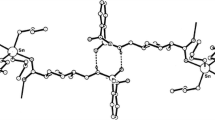Abstract
The crystal structure of the title compound has been determined from 1623 independent reflections measured by scintillation methods. The compound cyrstallizes in the monoclinic space groupP21/c witha = 10.60(2),b = 18.40(5),c = 17.05(3) Å, β = 116.7(2) °, andZ = 4. The structure was solved by Patterson and Fourier techniques and was refined by full-matrix least-squares methods toR = 0.066. As in tris(N, N-diethyldithiocarbamato)-methyltin(IV) the crystal structure consists of discrete, neutral, sevencoordinated tin complexes. The distorted pentagonal bipyramidal geometry of the tin atom is almost identical to that in the methyl complex, being formed by two sulfur atoms from each dithiocarbamate and a carbon atom of the butyl group which occupies one of the axial positions. Each dithiocarbamate ligand again has one Sn-S distance significantly shorter than the other. For the equatorial ligands the average difference is 0.18 Å with the minimum Sn-S distance 2.619(7) Å and the maximum 2.860(6) Å. For the ligand which bridges axial-equatorial, the Sn-S axial distance is 2.491(6) Å, while the Sn-S equatorial distance is 2.763(8) Å. The axial S-Sn-C angle is 166.3(5) °. The results are compared with those for other seven-coordinated tin(IV) structures and seven coordinated dithiocarbamate complexes of other metals.
Similar content being viewed by others
References
Brennan, T. F. and Bernai, I. (1973)Inorg. Chim. Acta 7, 283.
Brownlee, G. S., Walker, A., Nyburg, S. C., and Szymanski, J. T. (1971)Chem. Commun., 1073.
Dewan, J. C., Kepert, D. L., Raston, C. L., Taylor, D., White, A. H., and Masler, E. N. (1973)J. Chem. Soc. Dalton Trans., 2082.
Esperas, S., and Husebye, S. (1972)Acta Chem. Scand. 26, 3293.
Ibers, J. A., and Hamilton, W. C. (1964)Acta Cryst. 17, 781.
International Tables for X-Ray Crystallography (1962) Vol. III, (Kynoch Press, Birmingham, 1962).
Kazimir, E. O. A Mössbauer effect investigation of tin binding (1969) Ph.D. Thesis, Fordham University, New York.
May, J. C., Petridis, D., and Curran, C. (1971)Inorg. Chim. Acta 5, 511.
Mecke, A., Mecke, C., and Luttringhaus, R. (1955)Z. Naturforsch. 105B, 367.
Miller, G. A., and Schlemper, E. O. (1973)Inorg. Chem.,12, 677.
Morris, J. S., and Schlemper, E. O. (1978)J. Cryst. Mol. Struct. 8, 295.
Park, J. J., Collins, D. M., and Hoard, J. R. (1970)J. Am. Chem. Soc. 92, 3636.
Pauling, L. (1960)The Nature of the Chemical Bond, 3rd. edn. (Cornell University Press, Ithaca), p. 246.
Schlemper, E. O., and Harreid, C. S. (1971)Acta Cryst. B 27, 1964.
Author information
Authors and Affiliations
Rights and permissions
About this article
Cite this article
Steven Morris, J., Schlemper, E.O. Crystal and molecular structure of tin(IV) dithiocarbamates: III. Tris(N,N-diethyl-dithiocarbamato)n-butyltin(IV). Journal of Crystal and Molecular Structure 9, 1–12 (1979). https://doi.org/10.1007/BF01370922
Received:
Issue Date:
DOI: https://doi.org/10.1007/BF01370922




